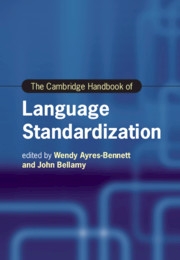Book contents
- The Cambridge Handbook of Language Standardization
- cambridge handbooks in language and linguistics
- The Cambridge Handbook of Language Standardization
- Copyright page
- Contents
- Figures
- Tables
- Contributors
- Introduction
- Part I Revisiting Models and Theories of Language Standardization
- Part II Legitimacy, Authority and the Written Form
- 7 Standard Languages in the Context of Language Policy and Planning and Language Rights
- 8 State-Appointed Institutions
- 9 Grammars, Dictionaries and Other Metalinguistic Texts in the Context of Language Standardization
- 10 An Industry Perspective
- 11 The Role of Literature in Language Standardization
- 12 Standardization, New Speakers and the Acceptance of (New) Standards
- 13 Creoles and Variation
- Part III Norms, Literacy and Education
- Part IV Beyond the National
- Part V Standardization in Late Modernity
- Name Index
- Subject Index
- References
7 - Standard Languages in the Context of Language Policy and Planning and Language Rights
from Part II - Legitimacy, Authority and the Written Form
Published online by Cambridge University Press: 01 July 2021
- The Cambridge Handbook of Language Standardization
- cambridge handbooks in language and linguistics
- The Cambridge Handbook of Language Standardization
- Copyright page
- Contents
- Figures
- Tables
- Contributors
- Introduction
- Part I Revisiting Models and Theories of Language Standardization
- Part II Legitimacy, Authority and the Written Form
- 7 Standard Languages in the Context of Language Policy and Planning and Language Rights
- 8 State-Appointed Institutions
- 9 Grammars, Dictionaries and Other Metalinguistic Texts in the Context of Language Standardization
- 10 An Industry Perspective
- 11 The Role of Literature in Language Standardization
- 12 Standardization, New Speakers and the Acceptance of (New) Standards
- 13 Creoles and Variation
- Part III Norms, Literacy and Education
- Part IV Beyond the National
- Part V Standardization in Late Modernity
- Name Index
- Subject Index
- References
Summary
Standardization is the selection of one variant among others. It may concern any aspect of language use – pronunciation, orthography, morphology, syntax, the lexicon – and can occur within any social group, from the family to international organizations. Language policy is a conscious choice regarding a language or a linguistic feature. Such a choice, made by some social authority, is then implemented through language policy. State intervention may depend on calls for efficiency or calls for equality. Each policy and each plan for implementation is situated within a specific historical context. We trace two national histories often represented as being at opposite ends of the spectrum: the centralized power of the state in France and the decentralized power distributed to states and smaller governmental units in the USA. There are as many histories as there are languages and language varieties.
Keywords
- Type
- Chapter
- Information
- The Cambridge Handbook of Language Standardization , pp. 201 - 233Publisher: Cambridge University PressPrint publication year: 2021
References
- 1
- Cited by



